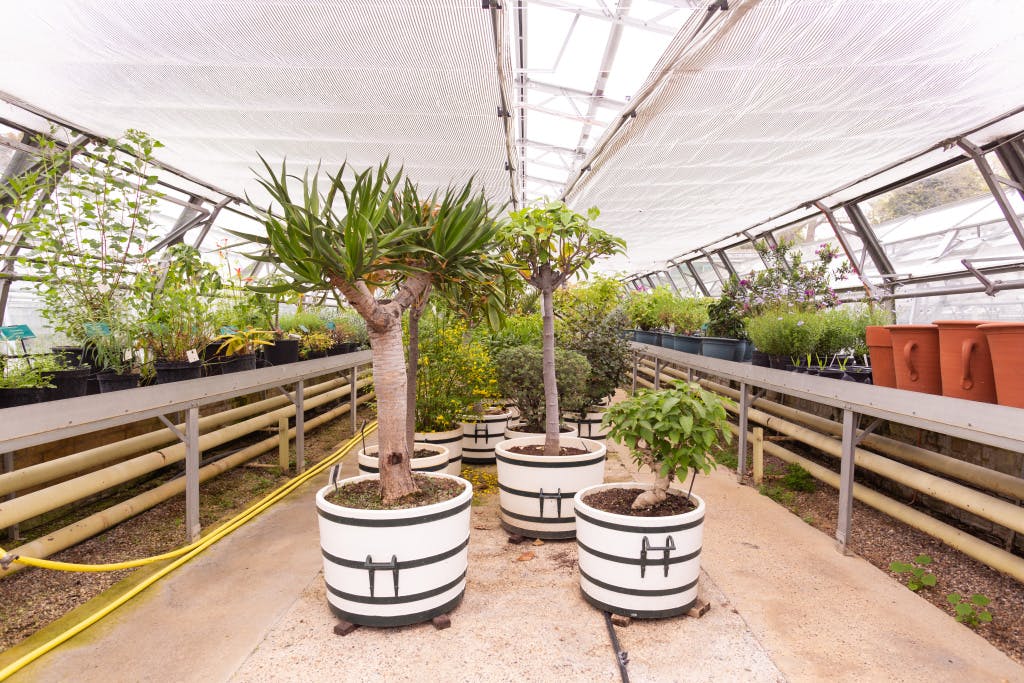Displaying Queen Mary II's Exoticks Collection
Date: 28 August 2019
Author:
Martin Einchcomb
You may well have heard of Queen Mary II's Exoticks Collection (17th-century spelling) or seen the plants in the gardens or in the glasshouse nurseries at Hampton Court. If you haven't, here is a brief description so you'll know what to look out for on your next visit.
William lll and Queen Mary ll were very keen horticulturalists (gardeners in layman's terms) and avid collectors of plants from various parts of the globe for their gardens in Holland and here at Hampton Court Palace. Every year, their vast collections were brought out of the glasshouses and put out on display during the warmer months in various pots of all shapes, sizes and designs.
Today, there are 256 species in the Exoticks collection. In the late 17th century under Mary II's keen enthusiasm, there were around 2000 different species of plants in this collection. Parts of Mary's collection survived until the First World War, but a lack of gardeners led to the last plants dying out. Since 1987, our Gardens and Estate team began rebuilding the collection. They researched the specimens in Mary's collection and started growing them once more through partnerships with local nurseries and British and European suppliers. The Exoticks are now recognised as a Heritage Collection.
In Mary II's day, this collection was so vast that she employed her own botanist, Dr Leonard Plukenet, to look after them. The plants were grown in small glass case houses in the Orangery garden to the south of the palace. Every year over the summer months, they are moved into the adjacent garden area nearby for display. This was quite a mammoth task for the seventeenth century gardens team - and it is still a huge task for the nursery team today.
Although we do have some mechanical means and trolleys to move them from the nursery to the Privy and Orangery, it is still a challenge. Here are a few facts to give you an idea of the effort in moving this restored historic collection during the months of May and June:
- 200 to 250 plants in terracotta pots of various sizes are loaded onto trolleys, transported and then manually carried into the Orangery garden.
- 130 to 150 wooden tubs of citrus and Exoticks are placed by hand into the gardens and with use of a forklift.
Despite the reduced size of the collection, it takes us up to two weeks to complete this move, maybe a bit longer depending on weather conditions and other work within the nursery. But the task was done on a much larger scale without machinery 300 years ago, and it's great to think that it's still being enacted today. It's a challenge, but so rewarding to show off the fruits of our labours, and let our visitors explore the exotic plants that we care for.
This content is hosted on YouTube
This content may be using cookies and other technologies for which we need your consent before loading. To view the content, you need to enable cookies for "Targeting Cookies & Other Technologies".
Manage CookiesMartin Einchcomb
Nursery Team Leader
Blog

Royal Trees at Hillsborough Castle and Gardens
31 May 2023
Claire Woods, Gardens Manager at Hillsborough Castle and Gardens, reflects on some of the trees planted by members of the Royal Family, which are still available to view in the castle grounds today, and the newest addition for 2023.

A tour of Kew's Kitchen Garden
10 September 2019
Like Kew Palace and the Royal Kitchens, the Kitchen Garden is open seasonally to visitors, from April to October. But work in the garden continues all year round. Let's take a tour...

Mistletoe in the Hampton Court Palace Gardens
20 December 2019
One of the most popular questions posed to our gardeners during winter concerns strange lumps of weed growing in trees in the East Front garden. These random and odd-looking growths are in fact clumps of mistletoe.


